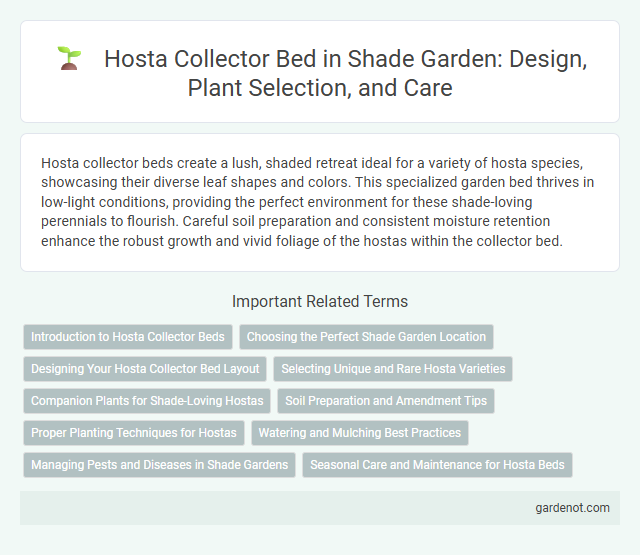Hosta collector beds create a lush, shaded retreat ideal for a variety of hosta species, showcasing their diverse leaf shapes and colors. This specialized garden bed thrives in low-light conditions, providing the perfect environment for these shade-loving perennials to flourish. Careful soil preparation and consistent moisture retention enhance the robust growth and vivid foliage of the hostas within the collector bed.
Introduction to Hosta Collector Beds
Hosta collector beds showcase a diverse range of Hosta cultivars, offering varying leaf shapes, sizes, and colors to create a dynamic shade garden focal point. These beds thrive in shaded or partially shaded areas with rich, well-drained soil that retains moisture without becoming waterlogged. Incorporating multiple Hosta varieties enhances visual interest throughout the growing season while providing habitat for beneficial insects.
Choosing the Perfect Shade Garden Location
Selecting the perfect shade garden location involves identifying areas with consistent partial to full shade, such as beneath deciduous trees or along north-facing walls. Soil should be well-draining, rich in organic matter, and retain moisture to support shade-loving plants like hostas. Positioning the hosta collector bed away from intense afternoon sun prevents leaf scorch and promotes lush, vibrant foliage growth.
Designing Your Hosta Collector Bed Layout
Design your Hosta collector bed layout by grouping varieties with contrasting leaf colors, sizes, and textures to create visual interest and depth. Incorporate shade-tolerant companion plants like ferns and astilbes to enhance the natural woodland aesthetic and improve soil moisture retention. Ensure proper spacing to accommodate mature growth and promote air circulation, reducing the risk of fungal diseases common in dense Hosta clusters.
Selecting Unique and Rare Hosta Varieties
Selecting unique and rare Hosta varieties enhances the visual appeal and biodiversity of a shade garden's collector bed. Varieties such as Hosta 'Empress Wu,' known for its enormous green leaves, and Hosta 'Great Expectations,' prized for its silvery centers and chartreuse margins, add distinctive textures and colors. Incorporating rare cultivars like Hosta 'Blue Mouse Ears' or Hosta 'August Moon' supports both plant conservation efforts and creates an eye-catching focal point for shade gardening enthusiasts.
Companion Plants for Shade-Loving Hostas
Hosta collector beds thrive with companion plants like ferns, astilbes, and heucheras that enhance shade tolerance and add contrasting textures. These plants improve soil moisture retention and create visually appealing layers of foliage and color. Incorporating shade-loving companions also supports pest resistance and promotes a healthier garden ecosystem.
Soil Preparation and Amendment Tips
Hosta collector beds thrive in well-drained, fertile soil enriched with organic matter such as compost or aged leaf mold to improve moisture retention and nutrient availability. Incorporate a balanced slow-release fertilizer high in nitrogen and potassium to support lush foliage growth and vibrant leaf colors. Adjust soil pH to slightly acidic (around 6.0 to 7.0) for optimal nutrient uptake, ensuring a healthy environment for diverse hosta varieties.
Proper Planting Techniques for Hostas
Hosta collector beds thrive when planting techniques prioritize well-drained, organically rich soil with ample moisture retention to support their shallow root systems. Position hosta rhizomes just below the soil surface, spacing them 18 to 24 inches apart to ensure adequate airflow and reduce disease risk. Applying a 2-inch layer of mulch helps maintain consistent soil moisture and temperature, promoting healthy growth and vibrant foliage.
Watering and Mulching Best Practices
Hosta collector beds require consistent watering to maintain moist, well-drained soil, ideally providing about one inch of water per week through rainfall or irrigation. Applying a 2-3 inch layer of organic mulch, such as shredded bark or leaf mold, helps conserve soil moisture, regulate temperature, and suppress weeds. Mulching also improves soil structure and nutrient availability, promoting robust Hosta growth in shaded garden areas.
Managing Pests and Diseases in Shade Gardens
Hosta collector beds in shade gardens require vigilant pest management to prevent damage from slugs, aphids, and nematodes, which thrive in moist, shaded environments. Regular inspection and organic treatments such as neem oil or diatomaceous earth help maintain plant health while minimizing chemical use. Ensuring proper air circulation and avoiding overhead watering also reduce fungal diseases like crown rot and leaf spot common in shaded, damp conditions.
Seasonal Care and Maintenance for Hosta Beds
Hosta collector beds require consistent seasonal care to thrive, including regular watering during dry spells and mulching in spring to retain soil moisture and suppress weeds. Dividing clumps every 3 to 5 years promotes vigorous growth and prevents overcrowding, while removing yellowing or damaged leaves enhances plant health and appearance. Monitoring for slugs and applying organic pest controls helps protect foliage throughout the growing season.
Hosta collector bed Infographic

 gardenot.com
gardenot.com